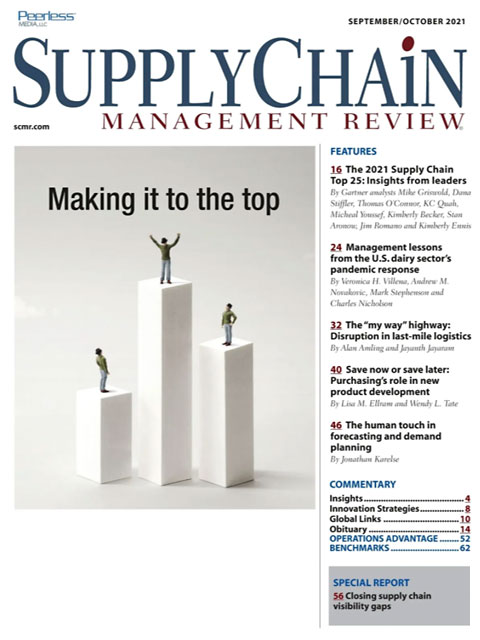Sorry, but your login has failed. Please recheck your login information and resubmit. If your subscription has expired, renew here.
September-October 2021
This time every year, we publish Gartner’s Top 25 supply chains, the annual list of the supply chains that have made it to the top, a list that now also includes 5 Masters, or companies that have consistently outperformed year after year. You can read the article in this issue, along with the web exclusive material we publish on scmr.com, to find out what it takes to become a supply chain leader. Browse this issue archive.Need Help? Contact customer service 847-559-7581 More options
It’s an annual ritual, extending back to 2007: Every fall, Apple introduces the latest model of the iPhone, an event that is awaited as anxiously as the winners of the Oscars and in some years, with as much press coverage and fanfare. Months before the still secretive date of the release of the iPhone 13, there were leaks and rumors about what to expect in the 2021 lineup. It’s anticipated that, as in most years, the new phone will set off a rush to stores, as customers look to upgrade their phones.
Apple’s success with the introduction of new products and services underscores a fact of business life: The development and introduction of new products is critical to the success of many organizations. While it can seem as if consumer electronics products have a shelf life equivalent to that of fresh fruit, industries across the spectrum from automobiles to wine and spirits depend on new products and features to maintain or gain market share. In recent years, Diageo, one of the world’s largest producers of alcoholic beverages, introduced more than 250 new products a year, driving more than $500 million in annual sales. Even a 100-plus year old company like 3M lets designers spend 15% of their time to pursue their own ideas and expects 30% of its revenue to come from products introduced in the past five years.
Whether creating innovative new products or variations of current ones, new products help maintain and grow market share through customer interest and loyalty. They also help the organization stay ahead of the competition. To be successful, new products need to be attractive to customers, timely and contribute to profitability. To achieve these goals, many firms rely on target costing or similar processes.

This complete article is available to subscribers only.
Log in now for full access or start your PLUS+ subscription for instant access.
SC
MR
Sorry, but your login has failed. Please recheck your login information and resubmit. If your subscription has expired, renew here.
September-October 2021
This time every year, we publish Gartner’s Top 25 supply chains, the annual list of the supply chains that have made it to the top, a list that now also includes 5 Masters, or companies that have consistently… Browse this issue archive. Access your online digital edition. Download a PDF file of the September-October 2021 issue.It’s an annual ritual, extending back to 2007: Every fall, Apple introduces the latest model of the iPhone, an event that is awaited as anxiously as the winners of the Oscars and in some years, with as much press coverage and fanfare. Months before the still secretive date of the release of the iPhone 13, there were leaks and rumors about what to expect in the 2021 lineup. It’s anticipated that, as in most years, the new phone will set off a rush to stores, as customers look to upgrade their phones.
Apple’s success with the introduction of new products and services underscores a fact of business life: The development and introduction of new products is critical to the success of many organizations. While it can seem as if consumer electronics products have a shelf life equivalent to that of fresh fruit, industries across the spectrum from automobiles to wine and spirits depend on new products and features to maintain or gain market share. In recent years, Diageo, one of the world’s largest producers of alcoholic beverages, introduced more than 250 new products a year, driving more than $500 million in annual sales. Even a 100-plus year old company like 3M lets designers spend 15% of their time to pursue their own ideas and expects 30% of its revenue to come from products introduced in the past five years.
Whether creating innovative new products or variations of current ones, new products help maintain and grow market share through customer interest and loyalty. They also help the organization stay ahead of the competition. To be successful, new products need to be attractive to customers, timely and contribute to profitability. To achieve these goals, many firms rely on target costing or similar processes.
SC
MR


Latest Supply Chain News
- 6 Questions With … Sandeep Bhide
- MIT CTL offering humanitarian logistics course
- Bridging the ESG gap in supply chain management: From ambition to action
- Few executives believe their supply chains can respond quickly to disruptions
- Technology’s role in mending supply chain fragility after recent disruptions
- More News
Latest Podcast

 Explore
Explore
Procurement & Sourcing News
- Bridging the ESG gap in supply chain management: From ambition to action
- Israel, Ukraine aid package to increase pressure on aerospace and defense supply chains
- How CPG brands can deliver on supplier diversity promises
- How S&OP provides the answer to in-demand products
- There is still work to do to achieve supply chain stability
- Blooming success: The vital role of S&OE in nurturing global supply chains
- More Procurement & Sourcing
Latest Procurement & Sourcing Resources

Subscribe

Supply Chain Management Review delivers the best industry content.

Editors’ Picks






